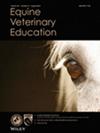Outcome following standing flank laparotomy for treatment of uterine torsion in 87 Arabian mares
Abstract
Background
Uterine torsion (UT) is an infrequent serious obstetric disorder in pregnant mares.
Objective
To record the outcome of standing flank laparotomy (SFL) for correction of UT in Straight Egyptian Arabian mares.
Study design
Retrospective analysis of medical records.
Methods
Hospital records of all pregnant mares that underwent SFL for correction of UT between 2018 and 2022 were analysed. The signalment, history, clinical signs, results of diagnostic techniques, direction and degree of UT, treatment and outcome, rebreeding and recurrence were retrieved and analysed.
Results
Out of 97 mares treated with SFL for correction of UT, 87 (89.7%) animals were Straight Egyptian Arabian mares. The median age of the Straight Egyptian Arabian mares presented with UT was 12 ± 2.3 years (Range: 5–18 and IQR: 7–15 years). The median gestational age at the time of occurrence of UT was 270 ± 2.4 days (Range: 210–315 and IQR: 255–260 days). The majority of UT (75.9%) was recorded ≤270 days. The direction of torsion was clockwise in 36 (41.4%) mares and anticlockwise in 51 (58.6%) mares. The degree of UT ranged between <180° and ≥360°. After surgery, 82/87 (94.3%) mares successfully delivered a live foal. However, four mares (4.6%) aborted after 2–15 days of surgery and one mare (1.1%) died after surgery due to rectal tears and intestinal prolapse. Following SFL, 86/87 (98.9%) mares survived. Of the surviving 86 mares, 82 (95.3%) gave birth to viable mature foals. In contrast to the direction of torsion and gender of the foal, the stage of gestation at which UT occurred significantly affected foal survival (p = 0.018).
Conclusion
Pregnant Straight Egyptian Arabian mares are at risk of developing UT during the third trimester of pregnancy. Standing flank laparotomy is an effective operation for treating UT in mares, with good foal and mare survival rates.


 求助内容:
求助内容: 应助结果提醒方式:
应助结果提醒方式:


